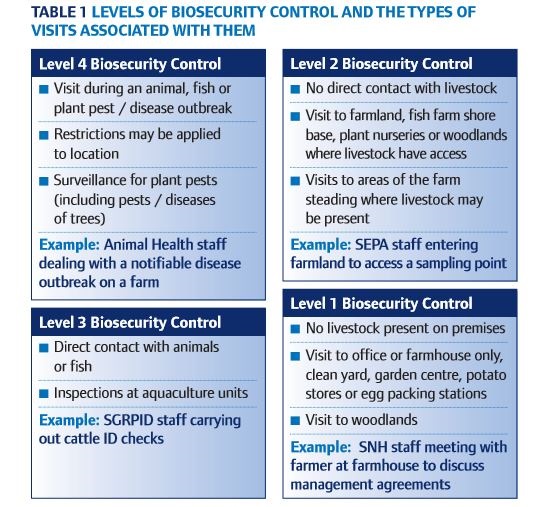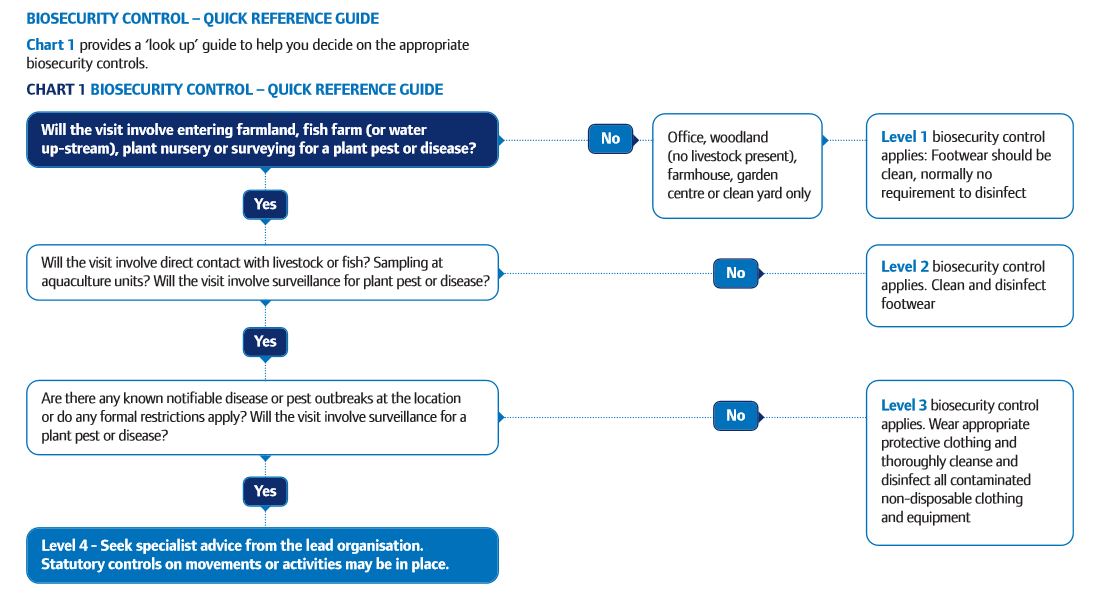Biosecurity practices for animal health: guidance for public sector staff
Management practices that collectively reduce the potential for the introduction or spread of animal disease-causing organisms onto and between farms.
Biosecurity controls
The risk of spreading pests or disease between different locations is influenced by:
- the extent and reason for the visit
- the type of premises
- the proximity to fisheries, crops, livestock or areas where livestock have access
- if there are any current pests or diseases present or restrictions applied to premises
Risk of pest and disease spread and level of biosecurity control
Table 1 describes four levels of biosecurity control and indicates when you should practise each level.
Level 1 control covers the lowest risk activities going up to Level 4 which is the highest level and used where a notifiable disease outbreak has been declared or identified on the premises.

Levels of biosecurity control
The level of biosecurity control you should practise will vary from simply ensuring footwear is clean (level 1) to disinfecting footwear (level 2), to wearing appropriate personal protection clothing which, together with any contaminated equipment, can be thoroughly cleaned and disinfected (level 3), to seeking specialist advice and possibly needing official authorisation before entering a location under restrictions (level 4).
The following sections describe what you need to do under each level of control before and after each time. Depending on the specific circumstances, you may need more rigorous controls, for example many intensive livestock farms have their own specific biosecurity requirements.
Level 1 biosecurity control: low risk
This is the minimum level of biosecurity control you should practise when entering any premises on business. As in Table 1 this standard of control is normally sufficient when visiting farmhouses, offices, woodlands, garden centres and clean areas of farm steadings where livestock are not present. You should:
- ensure footwear is clean (visually free from soil and debris). If necessary brush or wash in soapy water
- ensure vehicle is kept clean and, in particular, remove any accumulated mud
- make use of any facilities provided at the premises to clean footwear if required by the site or land manager
- keep access to a minimum, do not access areas unnecessarily and if practical do not take vehicles onto premises and keep to established tracks
- respect any notices or instructions
Level 2 biosecurity control
If you are entering farmland or parts of a farm steading where livestock may be present or crops grown, the risk of spreading disease increases and you need to take some extra precautions in addition to those listed in level 1. This level also applies if you visit fish farm shorebases or you inspect nurseries and plants. Where possible you should plan visits involving plants and plant material to inspect high grade stocks before lower grade material, to reduce the risk of transmitting plant pests or diseases. You should:
- clean and disinfect footwear (see section 3 for guidance on disinfection)
- if vehicle has entered an area where livestock have access, ensure the tyres and wheel arches are adequately cleaned and disinfected
Level 3 biosecurity control
If you will be coming into direct contact or physically handling livestock or fish or carrying out sampling or inspections at fish farms, the risk of coming into contact with pathogens or infected material increases. You must wear appropriate protective clothing which can be easily disinfected or disposed of to minimise the risk of carrying any disease to other premises. In fresh water situations, when working in waterbodies dealing with potential disease, parasites or non-native invasive species, it is good practice to clean and disinfect all relevant equipment when working between catchments. Take care to avoid transporting any non-native invasive species between waterbodies. You shoukd:
- ensure that footwear and vehicles are clean and disinfected as required before and after visits (see section 3 for guidance on disinfection)
- wear appropriate protective clothing which can be either disposed of after the visit or adequately cleaned and disinfected
- any equipment or other items used, which can range from needles to survey boats, should be appropriately disposed of or cleaned and disinfected after the visit
Level 4 biosecurity control: high risk
Different biosecurity arrangements may be necessary particularly if there is an exotic notifiable animal disease/plant pest or disease outbreak. If that happens, you should seek advice on how to proceed from the organisation responsible for dealing with the case. An outbreak of an ‘exotic notifiable’ animal disease is where the Chief Veterinary Officer has confirmed the presence of disease, for example foot and mouth disease or Newcastle disease.
If the site is under specific disease control restrictions or notifiable diseases are known to be present, always follow the advice of the lead organisation. For plant pest and disease outbreaks or plant pest surveillance work, before you visit a site, you should seek advice from:
For plant health issues not relating to woodlands:
- The Forestry Commission Plant Health Service on 0131 314 6414 for forestry related matters.
For advice on fish diseases, contact:
- Marine Scotland on 01224 876544 (marine) or 01796 472060 (fresh water).
For advice in relation to animal disease, contact:
- Scottish Government, Animal Health and Welfare on 0131 244 9874.
Biosecurity control: quick reference guide

Contact
Email: ceu@gov.scot
Telephone: 0300 244 4000 (Central Enquiry Unit)
Scottish Government
Agriculture and Rural Economy Directorate
Saughton House
Edinburgh
There is a problem
Thanks for your feedback